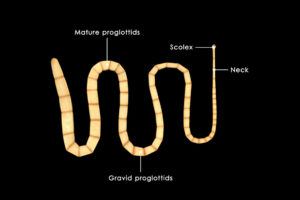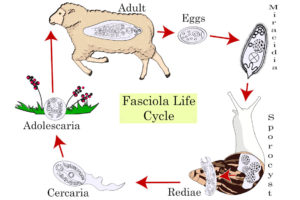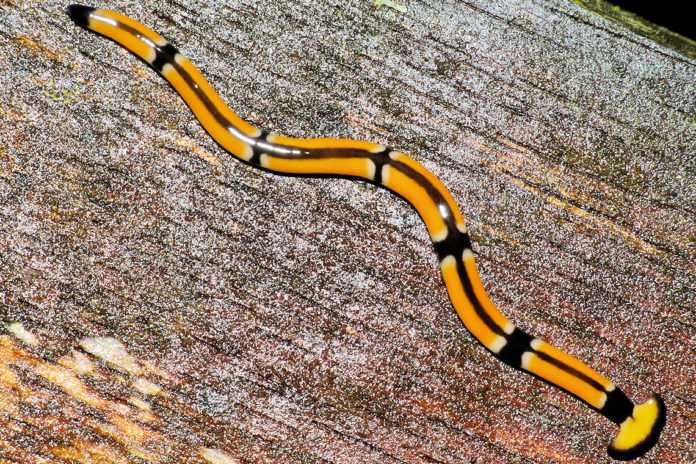Platyhelminthes are the flatworms. Basic phylum Platyhelminthes traits are bilateral symmetry and absence of a backbone. They lack a body cavity and segmentation. Their bodies have three layers of tissues.
Flatworms have organs and organ systems. The flatworms have nervous, digestive, excretory and reproductive systems. However, they do not have circulatory or respiratory systems.
Platyhelminthes are soft-bodied worms. There are three main classes in the phylum. There are 20,000 species in this phylum. The Turbellaria are a predator class. Planaria belong to this class. Second, Trematoda is a class of parasitic flatworms. Flukes belong to the Trematoda class. Finally, there is the Cestoda class. These are ribbon like parasites. Tapeworms belong to this class.
Phylum Platyhelminthes Traits
Multicellular Organisms
Platyhelminthes are multicellular. Their cells form tissues and organs. In turn, organs form organ systems. Flatworms have a brain and nervous system. Additionally, flatworms have digestive and excretory systems. And, they have a reproductive system. However, there is no circulatory or respiratory system.

[Click on the thumbnail image for a full-sized image].
Bilateral Symmetry: Flatworms have bilateral symmetry. Their right and left halves are mirror images. Bilateral symmetry is an advance in the evolution of life. This permits different parts of an animal to become specialized.
For example, planaria have a head. The head has eyespots that detect light. As a result, eyespots can detect food, danger, and mates.
Cell Layers: Flatworms have three embryonic cell layers. These layers develop into different body tissues. These layers are the endoderm, mesoderm and ectoderm. The outer ectoderm develops into the nervous system. The middle layer mesoderm develops skeleton and muscles. Last, the endoderm develops organs for digestion and intestines.
Solid Body: Unlike the Porifera and Cnidaria, flatworms have a solid body. They do not have a body cavity filled with water. Instead, they have a solid body of tissues. These tissues surround a digestive gut.
Digestion and Excretion

[Click on the thumbnail image for a full-sized image].
Free Living: Planaria are free living flatworms. They consume small animals and organic matter. Planaria are carnivores. They have a digestive cavity. The cavity has a mouth that also functions as an anus. Food enters the cavity and is digested. Finally, wastes are eliminated through the mouth.
Parasite: On the other hand, the tapeworm is a parasite. It is not free living. Instead, tapeworms live within the body of another animal. The head of the tapeworm lacks sensory organs. Tapeworm heads attach to the intestines of a host animal. Food is directly absorbed from the host. Nutrients enter through the walls of its body. As a result, tapeworms do not have a digestive cavity.
The tapeworm excretory system consist of little tubes. These tubes are covered with flame cells. Flame cells move water and wastes into these tubes. Last, wastes exit through pores in the body wall.
Respiration and Circulation
Platyhelminths lack a circulatory system. Circulatory systems move oxygen, fluids, and food through the body. Instead, flatworm cells move these items directly through each cell wall.
Reproduction

[Click on the thumbnail image for a full-sized image].
There are many reproductive systems in this phylum. Many flatworms are hermaphrodites. This means they have male and female organs.
Some parasitic flatworms have a complex life cycle. In this cycle, there are multiple larval forms and hosts.
In addition, other flatworms can reproduce asexually. When divided, one flatworm will result in two individuals.
Nervous System
Members of the Platyhelminthes phylum have simple nervous systems. In the Planaria illustration, nerve cords are shown. They run the length of the body. Sensory ability comes from pits, tentacles, and eye spots. These features are able to sense food, chemicals and light.
Phylum Platyhelminthes Classification
There are 20,000 species of flatworms. They represent the simplest life form with organs. These flatworms are classified into three major classes. These are the Turbellaria, Trematoda and Cestoda classes.
Class Turbellaria
There are nearly 5,000 Turbellaria species. Most are free living. They are predators or scavengers. Most have sensory abilities to detect food. Food is eaten and wastes expelled through a single mouth.
Turbellarians are mobile. Movement may be through fine hair cilia. Whole body muscular actions are used by larger flatworms. Others have a sole that allows creeping like a snail. Reproduction can be sexual or asexual. Planaria belong to this class.
Class Trematoda

[Click on the thumbnail image for a full-sized image].
Flukes belong to the Trematoda class. The Fasciola illustration above shows a complex life cycle. The first stage of the cycle are eggs. Eggs are excreted by a mammal and consumed by snails. Then, the eggs hatch into miracidia.
The miracidia turn into cercaria which are expelled by the snail. The cercaria attach to plants and become cysts. Then, these cysts are consumed by mammals. Finally, the cysts mature into adults within the host.
Class Cestoda
Tapeworms belong to the Cestoda class. All members of this class are parasites. They have complex life cycles. They often require more than one host and go through several life forms. Their bodies are made of many segments. Each segment has reproductive abilities.
Reflection
Vocabulary
- circulation
- host
- parasite
Notes
- Platyhelminthes are flatworms. There are 20,000 species in the phylum.
- Phylum Platyhelminthes traits include bilateral symmetry and presence of organs. They lack respiratory and circulatory systems.
- The three major classes are Turbellaria, Trematoda, and Cestoda.
Bibliography
- A Animals Study Guide
- About Animals
- The Flatworms and Tapeworms, Earthlife.

